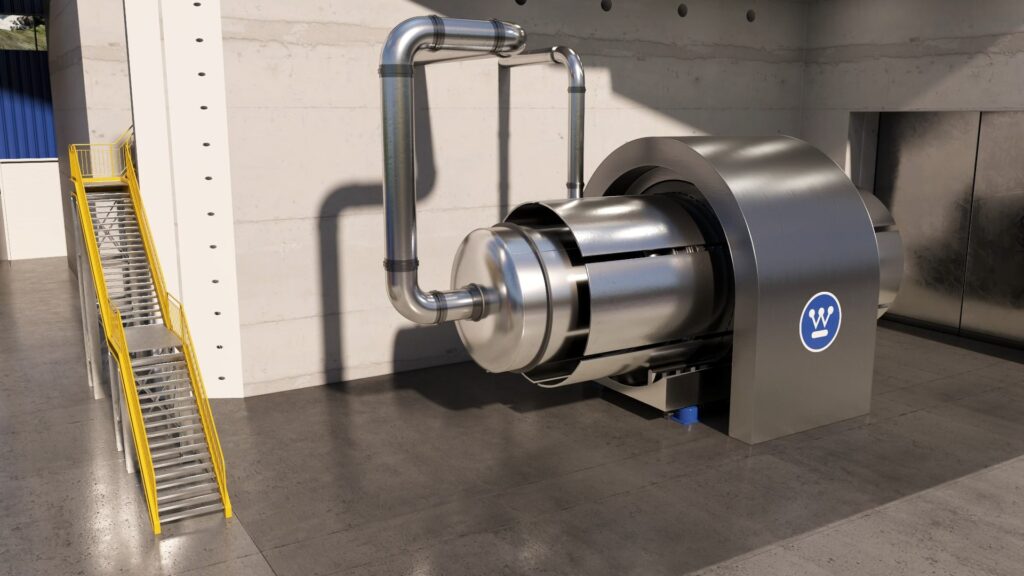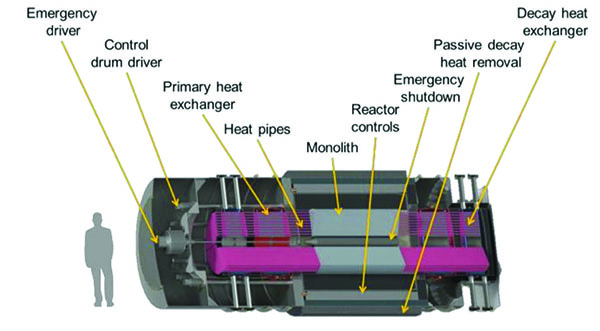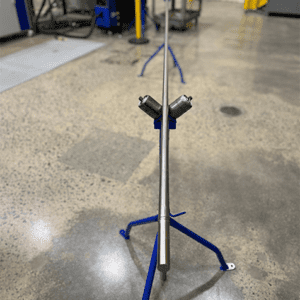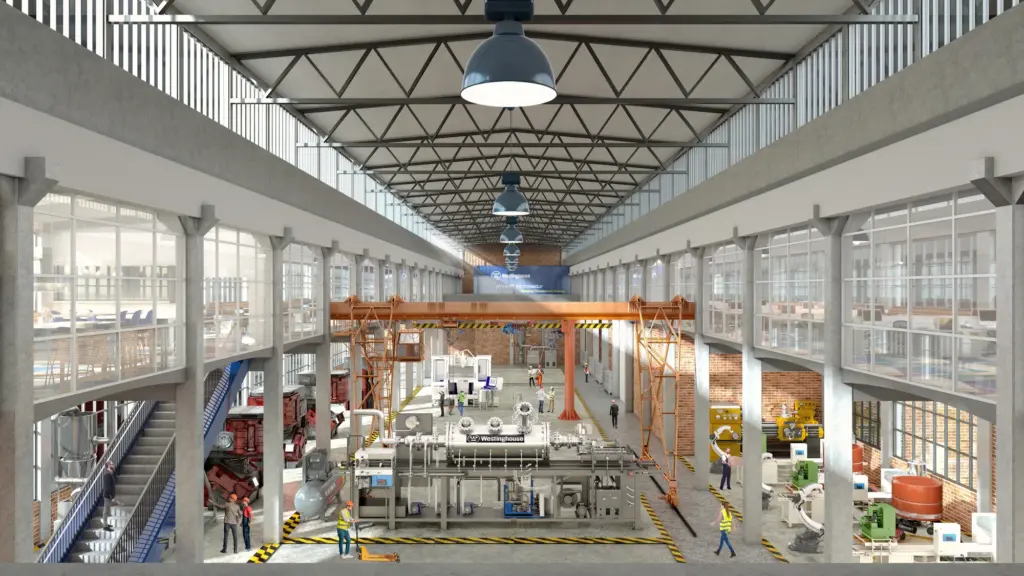Westinghouse Secures First Customer for eVinci Nuclear Microreactor
Westinghouse’s first customer for its eVinci microreactor—a flagship 5-MWe/13-MWth “nuclear battery”—is poised to be the Saskatchewan Research Council (SRC), Canada’s second-largest research and technology organization.
SRC—a Saskatchewan government Treasury Board Crown Corporation that serves as a commercial laboratory to provide research and development (R&D) for Saskatchewan industries—on Nov. 27 said it plans to pilot an eVinci microreactor by 2029. However, that timeframe will be subject to licensing and regulatory requirements. The location of the eVinci microreactor will be “determined as the project progresses,” the provincial government said on Monday.
SRC, which will serve as the microreactor’s licensed operator, will pursue the demonstration boosted with CA$80 million in government funding announced by Saskatchewan Premier Scott Moe on Monday. The CA$80 million will cover “SRC’s costs for licensing and SRC’s project costs,” SRC told POWER. “We will be working with Westinghouse to learn how this technology can be applied in Saskatchewan, and part of that will be to understand project costs for future deployments,” it said.

An Industrial Application That Could Lay ‘Groundwork’ for More Projects
If built by the anticipated timeframe, the eVinci demonstration would become Saskatchewan’s first advanced nuclear reactor. SaskPower, a utility owned by the provincial government, has selected GE Hitachi Nuclear Energy’s (GEH’s) 300-MW BWRX-300 for its first two potential nuclear units. While SaskPower intends to decide to build the new nuclear units in 2029, it suggests construction of the first small modular reactor (SMR) could begin as early as 2030, with a targeted in-service date of 2034. In August, Canada’s federal government committed CA$74 million to support SaskPower’s potential deployment through two federal mechanisms.
Last year, the Canadian federal government awarded Westinghouse a CA$27.2 million grant from its Strategic Innovation Fund (SIF) to support further development of the eVinci microreactor. The “investment” is aimed at helping to fight climate change and “build on Canada’s global leadership in SMRs,” said François-Philippe Champagne, Minister of Innovation, Science and Industry.
SRC’s effort to pilot an eVinci microreactor follows a May 2022–signed memorandum of understanding (MOU) between Westinghouse and SRC to jointly develop a project to locate an eVinci microreactor in Saskatchewan. “Our vision is to see the first eVinci microreactor in an industrial application and lay the groundwork for many more projects in the future,” SRC President and CEO Mike Crabtree said on Monday. “What we learn through this project will prepare SRC to assist communities and industries in future projects.”
SRC, notably, served as the licensed owner and operator of the SLOWPOKE-2, a 20-kW nuclear research reactor housed at the SRC Environmental Analytical Laboratories in Saskatoon. The 1981-commissioned research reactor ran for 38 years until decommissioned in 2019. While SLOWPOKE-2 provided an intense neutron source for teaching, training, and research, SRC has suggested an eVinci microreactor could be developed as a distributed energy alternative to diesel-powered generators.
Providing a reliable source of industrial-grade heat—of up to 600C—or operating in combined heat and power mode, the “very small modular reactor” could support various applications in the province, including remote mining operations, remote communities, and industry. It says the microreactor could also serve as a crucial energy source to power distributed hydrogen generation, desalination, and other integrated energy applications.
A Major Milestone for Westinghouse’s Novel Nuclear Battery
Bagging a first customer for the eVinci marks a big win for Westinghouse. While Westinghouse has long-fielded a research and development (R&D) effort, including developing and testing components for its heat pipe and novel moderator, it has more recently picked up the pace of its varied eVinci business activities to ready it for the market by 2027.
The nuclear technology giant introduced eVinci in 2017 as one of several key advanced nuclear designs in its portfolio, touting the microreactor’s innovative design, which has several safety features and is based on design simplicity. At the time, Westinghouse set an ambitious six-year technology development goal, anticipating that the next-generation nuclear reactor would be integral for decentralized generation markets.
At the heart of the eVinci is a fully passive heat pipe–cooled design that will use tristructural isotropic (TRISO) fuel. Its alkali metal heat pipe technology relies on alkali metal phase change to capture temperature uniformity within the reactor core. The reactor’s core, built around a solid steel monolith, has channels for both heat pipes and fuel pellets, with each fuel pin placed adjacent to several heat pipes. The array of closed heat pipes essentially removes heat from the nuclear core and transfers that heat to air, which then turns a turbine in an open-air Brayton thermodynamic power conversion cycle.

Along with providing redundancy of the primary heat removal path, the heat pipes eliminate the need for a reactor coolant pump, bulk coolant, and associated equipment, as well as enable a modular core design, Westinghouse President of eVinci Microreactor Jon Ball told POWER in October.
An eVinci microreactor and surrounding infrastructure is about “half the size of a hockey rink,” Westinghouse says. In addition, unlike a high-temperature gas reactor (HTGR), heat pipe reactors are not pressurized and have no moving parts, though they are passive (naturally driven) and can self-adjust to the amount of heat transferred—which allows inherent load following.
Readying eVinci for Market
However, while heat pipe technology is not new—the passive heat transport devices have been applied for nearly 60 years in aerospace and other industries and are mature and robust with an extensive experimental test database—they have not been utilized in commercial nuclear technology. eVinci, notably, will also utilize high-assay low-enriched uranium (HALEU) in TRISO form, further contributing to the reactor’s safety and efficiency.
Following Westinghouse’s recent success in manufacturing a 12-foot heat pipe at its Waltz Mill, Pennsylvania, facility (as part of a $9 million federal cost-share project under the Advanced Reactor Demonstration Program), the company has garnered a series of crucial partnerships with potential customers.

In June, Westinghouse moved to establish eVinci Technologies as a separate business unit, with Ball—a long-time nuclear expert who was pivotal in leading the creation, development, and customer adoption of GE Hitachi’s BWRX-300—at its helm. In October, Westinghouse then launched a new design and manufacturing facility near downtown Pittsburgh that will house eVinci’s engineering and licensing operations, testing, prototype trials, business development, and sales. Construction on the facility is slated to wrap up early in 2024.
Also in October, the Department of Energy (DOE) revealed eVinci would be part of its first batch of microreactors to further their designs through a front-end engineering and experiment design (FEEED) process at Idaho National Laboratory’s (INL’s) DOME test bed. Testing at DOME could start “as early as 2026,” the DOE said.

Crucial Next Steps: Scaling Up, Licensing
Ball told POWER eVinci’s nuclear test reactor (NTR) at DOME will be “roughly a one-fifth scale version of the commercial eVinci that we’re planning to license and deploy.” The reason Westinghouse is testing the NTR at DOME is that the company is in the process of scaling up some of the laboratory testing that has already been performed on the system, Ball said. “Ultimately, what we need to be able to do is demonstrate the scaling and our understanding of the core performance, which will be a key aspect in terms of the licensing of the eVinci commercial system,” he added.
Once Westinghouse has completed the NTR, it plans to scale up its ability to manufacture longer heat pipes required for its commercial system. “We’ve made tremendous progress to date and have every confidence that we’re going to be successful as we continue to scale the system to our commercial size,” Ball said.
The next crucial step will be to license the eVinci. In the U.S., Westinghouse has already submitted 31 technical white papers detailing the eVinci reactor’s safety aspects and three topical reports to the U.S. Nuclear Regulatory Commission (NRC), considering a license submission under 10 CFR Part 52.
In 2021, the company said it planned a comprehensive testing and analysis program that would be sufficient for the Design Certification (DC) of the “eVinci facility,” which would support the deployment of standard eVinci reactors for a range of sites in the U.S. However, in addition to a DC, it said it intended to explore various licenses, including a manufacturing license (10 CFR 52 Subpart F), a certificate of compliance, and a license for transport (10 CFR 71).
In Canada, Westinghouse has initiated the Vendor Design Review (VDR) process, submitting its first package to the Canadian Nuclear Safety Commission (CNSC) in June. On Monday, SRC told POWER it would lead the licensing process for the Saskatchewan’s first deployment. “CNSC regulations must be met,” it noted. “The CNSC makes licensing decisions for reactors and reactor operators in Canada.”
Westinghouse is also working with both regulators—the NRC and the CNSC—to coordinate the evaluation of future joint reviews on “a couple of key topics,” Ball said. “Those documents have not been submitted yet, but that is the near-term intent, to submit the first package that will have a joint review,” he said.
—Sonal Patel is a POWER senior associate editor (@sonalcpatel, @POWERmagazine).
Updated (Nov. 27): Adds details about project cost and SRC’s role in the project.